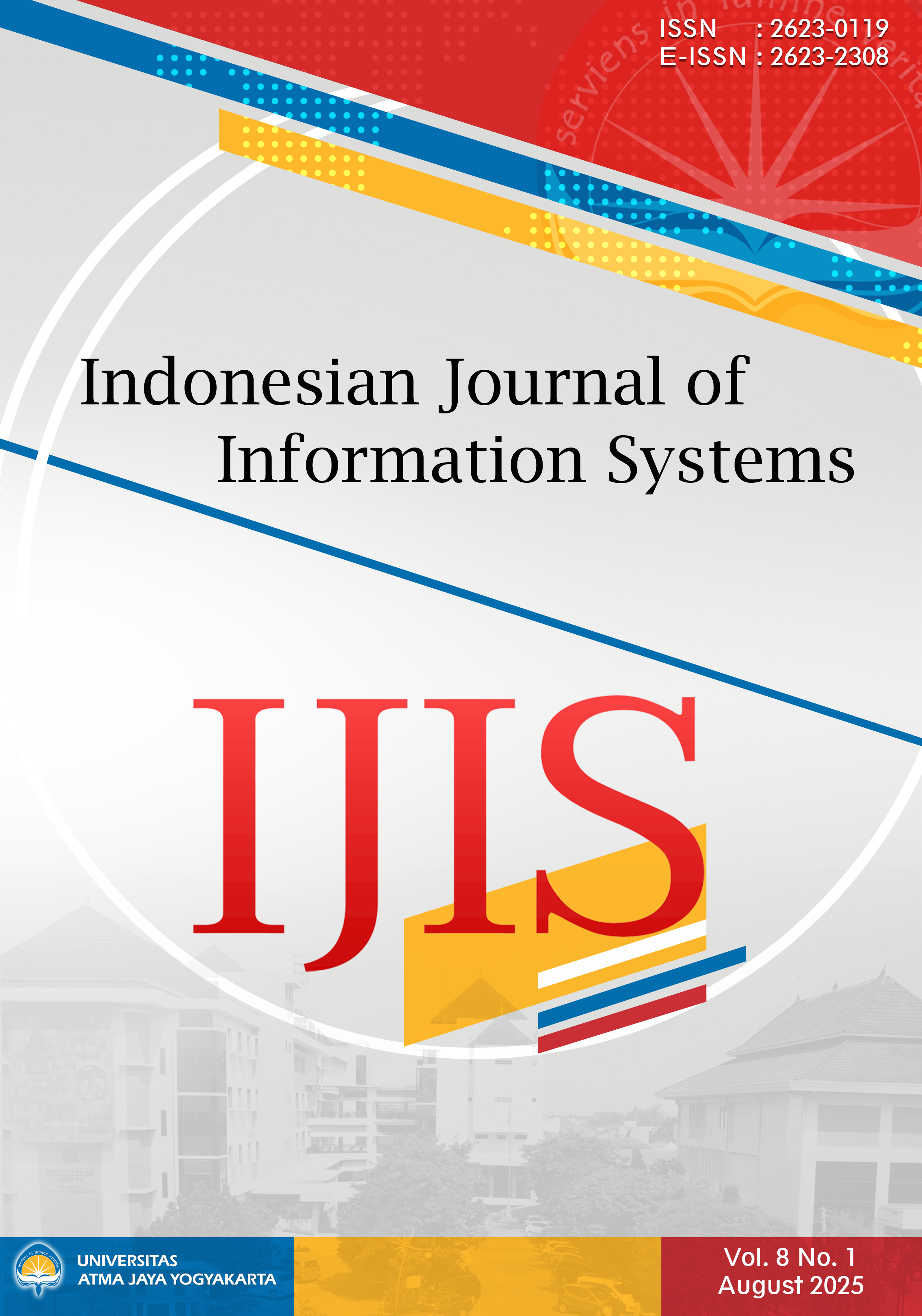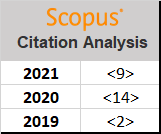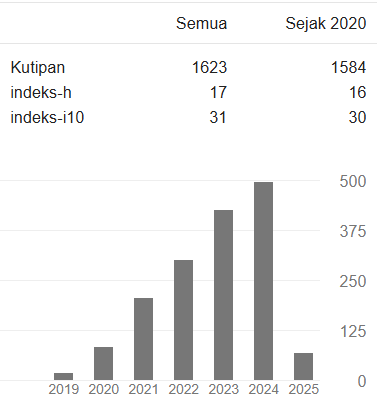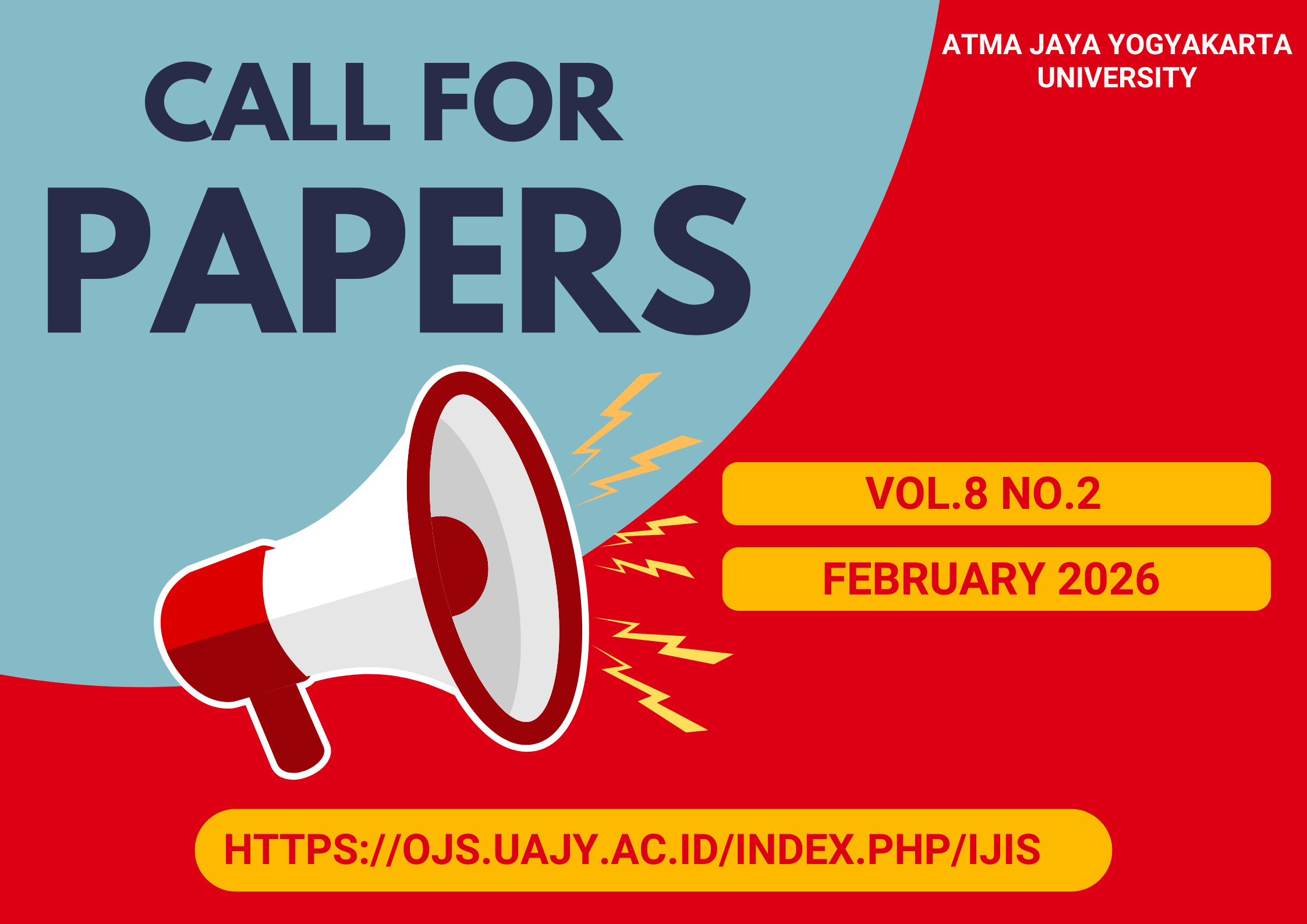Forced eLearning Acceptance using TPB: High School vs University Students
DOI:
https://doi.org/10.24002/ijis.v8i1.11142Abstract
Covid 19 Pandemic has forced Indonesian students to utilize eLearning tools. This article tests the acceptance of forced eLearning by Indonesian high school and students using Theory of Planned Behavior. The study extended original TPB to include Perceived Cost, Perceived Risks, Trust (both organization and application), Perceived Ease of Used, Perceived Usefulness, Controllability, and Self-efficacy. We also conducted Multi Group Analysis to see if university students and high school students have differences in their acceptance.
References
[1] R. Subramaniam, S. P. Singh, P. Padmanabhan, B. Gulyás, P. Palakkeel, and R. Sreedharan, "Positive and Negative Impacts of COVID-19 in Digital Transformation," Sustainability, vol. 13, pp. 1-18, 2021, doi: https://doi.org/10.3390/su13169470.
[2] L. Nagel, "The influence of the COVID-19 pandemic on the digital transformation of work," International Journal of Sociology and Social Policy, vol. 40, no. 9/10, pp. 861-875, 2020, doi: https://doi.org/10.1108/IJSSP-07-2020-0323.
[3] Y. Zhu and S. Jin, "COVID-19, Digital Transformation of Banks, and Operational Capabilities of Commercial Banks," Sustainability, vol. 15, pp. 1-17, 2023, doi: https://doi.org/10.3390/su15118783.
[4] A. Ridwansyah, D. C. Lantu, and Y. Anggoro, "Leadership dimensions and behaviors in business schools’ forced digital transformation," INTERNATIONAL JOURNAL OF RESEARCH IN BUSINESS AND SOCIAL SCIENCE, vol. 12, no. 3, pp. 159-170, 2023, doi: https://doi.org/10.20525/ijrbs.v12i3.2501.
[5] Z. Szuts, G. Molnár, R. Racsko, G. Vaughan, and T. L. Molnár, "Pedagogical Implications and Methodological Possibilities of Digital Transformation in Digital Education after the COVID-19 Epidemic," Computers vol. 12, no. 73, pp. 1-19, 2023, doi: https://doi.org/10.3390/computers12040073.
[6] R. Rupeika-Apoga, K. Petrovska, and L. Bule, "The Effect of Digital Orientation and Digital Capability on Digital Transformation of SMEs during the COVID-19 Pandemic," Journal of Theoretical and PPlied Electronic Commerce Research, vol. 17, pp. 669-685, 2022, doi: https://doi.org/10.3390/jtaer17020035.
[7] J. Nam, S. Kim, and Y. Jung, "Elderly Users’ Emotional and Behavioral Responses to Self-Service Technology in Fast-Food Restaurants," BEhavioral Sciences, vol. 13, no. 4, pp. 284-300, 2023, doi: https://doi.org/10.3390/bs13040284.
[8] S. Sharma and M. Sharma, "Impact of Digital Transformation on Academicians’ Well-being: A Study with the Moderating Role of Public and Private Universities in India," Digital Education Review, vol. December 2022, no. 42, pp. 118-135, 2022, doi: https://doi.org/10.1344/der.2022.42.118-135.
[9] A. L. Popova, P. A. Nuttunen, M. V. Kanavtsev, and V. A. Serditov, "The impact of the digital divide on the development of socio economic systems," in International AgroScience Conference, Cheboksary, Russia, 1-2 June 2019 2019, vol. 433, pp. 1-10, doi: https://doi.org/10.1088/1755-1315/433/1/012022.
[10] S. Sarosa, "Forced elearning usage: Extending theory of planned behaviour with perceived cost during Covid 19 pandemic," in 14th IADIS International Conference Information Systems 2021, IS 2021, Virtual, Online, 3-5 March 2021 2021: IADIS, pp. 121-128.
[11] S. Sarosa, "The effect of perceived risks and perceived cost on using online learning by high school students," Procedia Computer Science, vol. 197, pp. 477-483, 2022, doi: https://doi.org/10.1016/j.procs.2021.12.164.
[12] S. Sarosa and A. R. Setyowati, "Trust and Perceived Risks in High School Students' Online Learning Behaviour During Covid19 Pandemic," INTENSIF: Jurnal Ilmiah Penelitian dan Penerapan Teknologi Sistem Informasi, vol. 6, no. 1, pp. 66-80, 2022, doi: https://doi.org/10.29407/intensif.v6i1.16477.
[13] I. Ajzen, "The Theory of Planned Behavior," Organizational Behavior and Human Decision Processes, vol. 50, no. 2, pp. 179-211, 1991, doi: https://doi.org/10.1016/0749-5978(91)90020-T.
[14] D. Hrubes, I. Ajzen, and J. Daigle, "Predicting Hunting Intentions and Behavior: An Application of The Theory of Planned Behavior," Leisure Sciences, vol. 23, no. 3, pp. 165-178, 2001, doi: https://doi.org/10.1080/014904001316896855.
[15] H. Prapavessis, A. Gaston, and S. DeJesus, "The Theory of Planned Behavior as a model for understandingsedentary behavior," Psychology of Sport and Exercise, vol. 19, 2015, doi: https://doi.org/10.1016/j.psychsport.2015.02.001.
[16] E. W. L. Cheng, "Choosing between the theory of planned behavior (TPB) and the technology acceptance model (TAM)," Educational Technology Research and Development, vol. 67, pp. 21-37, 2019, doi: https://doi.org/10.1007/s11423-018-9598-6.
[17] E. H. Redda, "Attitudes towards Online Shopping: Application of the Theory of Planned Behaviour," ACTA UNIVERSITATIS DANUBIUS, vol. 15, no. 2, pp. 148-159, 2019. [Online]. Available: http://journals.univ-danubius.ro/index.php/oeconomica/article/view/5290.
[18] A. N. H. Ibrahim, M. N. Borhan, and R. A. O. K. Rahmat, "Understanding Users’ Intention to Use Park-and-Ride Facilities in Malaysia: The Role of Trust as a Novel Construct in the Theory of Planned Behaviour," Sustainability, vol. 12, 2020, doi: https://doi.org/10.3390/su12062484.
[19] T. T. Wei, G. Marthandan, A. Y.-L. Chong, K.-B. Ooi, and S. Arumugam, "What drives Malaysian m-commerce adoption? An empirical analysis," Industrial Management & Data Systems, vol. 109, no. 3, pp. 370-388, 2009, doi: https://doi.org/10.1108/02635570910939399.
[20] H. C. Yang and L. Zhou, "Extending TPB and TAM to mobile viral marketing: An exploratory study on American young consumers’ mobile viral marketing attitude, intent and behavior," Journal of Targeting, Measurement and Analysis for Marketing, vol. 19, pp. 85-98, 2011, doi: https://doi.org/10.1057/jt.2011.11.
[21] Q. Xie, W. Song, X. Peng, and M. Shabbir, "Predictors for e-government adoption: integrating TAM, TPB, trust and perceived risk," The Electronic Library, vol. 35, no. 1, pp. 2-20, 2017, doi: https://doi.org/10.1108/EL-08-2015-0141.
[22] A. Gurung and M. K. Raja, "Online privacy and security concerns of consumers," Information & Computer Security, vol. 24, no. 4, pp. 348-371, 2016, doi: https://doi.org/10.1108/ICS-05-2015-0020.
[23] C. Bianchi and L. Andrews, "Risk, trust, and consumer online purchasing behaviour: a Chilean perspective," International Marketing Review, vol. 29, no. 3, pp. 253-276, 2012, doi: https://doi.org/0.1108/02651331211229750.
[24] J.-H. Lee and C.-H. Song, "Effects of trust and perceived risk on user acceptance of a new technology service," Social Behavior and Personality, vol. 41, no. 4, pp. 587-598, 2013, doi: https://doi.org/10.2224/sbp.2013.41.4.587.
[25] J. Ejdys, R. Ginevicius, Z. Rozsa, and K. Janoskova, "The Role of Perceived Risk and Security Level in Building Trust in E-Government Solutions," E+M Ekonomie a Management, vol. 22, no. 3, pp. 220-235, 2019, doi: https://doi.org/10.15240/tul/001/2019-3-014.
[26] K. Chopra and W. A. Wallace, "Trust in Electronic Environments " in The 36th Hawaii International Conference on System Sciences, Hawaii, 2003, pp. 1-10, doi: https://doi.org/10.1109/HICSS.2003.1174902.
[27] J. Ejdys, "Building technology trust in ICT application at a university," International Journal of Emerging Markets, vol. 13, no. 5, pp. 980-997, 2018, doi: https://doi.org/10.1108/IJoEM-07-2017-023.
[28] N. Martin, J. Rice, and R. Martin, "Expectations of privacy and trust: examining the views of IT professionals," Behaviour & Information Technology, vol. 35, no. 6, pp. 500–510, 2016, doi: https://doi.org/10.1080/0144929X.2015.1066444.
[29] R. Baganzi and A. K. W. Lau, "Examining Trust and Risk in Mobile Money Acceptance in Uganda," Sustainability, vol. 9, no. 12, 2017, doi: https://doi.org/10.3390/su9122233.
[30] J. Khalilzadeh, A. B. Ozturk, and A. Bilgihan, "Security-related factors in extended UTAUT model for NFC based mobile payment in the restaurant industry," Computers in Human Behavior, vol. 70, pp. 460-474, 2017, doi: 10.1016/j.chb.2017.01.001.
[31] C. Osborne. "Zoom security: Your meetings will be safe and secure if you do these 10 things." ZDNet. https://www.zdnet.com/article/make-sure-your-zoom-meetings-are-safe-by-doing-these-10-things/ (accessed November 27th, 2020).
[32] A. R. Pratama, "Fun first, useful later: Mobile learning acceptance among secondary school students in Indonesia," Education and Information Technologies 2020, doi: 10.1007/s10639-020-10334-w.
[33] M. T. Rajeh, F. H. Abduljabbar, S. M. Alqahtani, F. J. Waly, I. Alnaami, A. Aljurayyan, and N. Alzaman, "Students’ satisfaction and continued intention toward e-learning: a theorybased study," Medical Education Online, vol. 26, no. 1, pp. 1-8, 2021, doi: 10.1080/10872981.2021.1961348.
[34] A. Rof, A. Bikfalvi, and P. Marques, "Pandemic-accelerated Digital Transformation of a Born Digital Higher Education Institution: Towards a Customized Multimode Learning Strategy," Educational Technology & Society, vol. 25, 1, pp. 124-141, 2022.
[35] M. H. Pakravan and N. MacCarty, "What Motivates Behavior Change? Analyzing User Intentions to Adopt Clean Technologies in Low-Resource Settings Using the Theory of Planned Behavior," Energies, vol. 13, 2020, doi: :10.3390/en13113021.
[36] W. H. Loo and H. P. Y. Y. Y. Y. Paul, "Antecedents of the responsible acquisition of computers behaviour: Integrating the theory of planned behaviour with the value-belief-norm theory and the habits variable," (in English), PLoS One, vol. 18, no. 6, Jun 2023
2024-10-24 2023, doi: https://doi.org/10.1371/journal.pone.0286022.
[37] R. B. Basnet, D. J. Lemay, and P. Bazelais, "Modeling students’ intentions to learn data science: Using an extended theory of planned behavior," (in English), Knowledge Management & E-Learning, vol. 16, no. 4, pp. 638-652, 2024
2025-03-10 2024, doi: https://doi.org/10.34105/j.kmel.2024.16.029.
[38] T. Clark, L. Foster, L. Sloan, and A. Bryman, Bryman's social research methods, Sixth edition. ed. (Social research methods). Oxford: Oxford University Press, 2021.
[39] V. Sheppard, Research Methods for the Social Sciences. Place of publication not identified: BCcampus, 2020.
[40] M. T. Liu, Y. Liu, and Z. Mo, "Moral norm is the key: An extension of the theory of planned behaviour (TPB) on Chinese consumers' green purchase intention," (in English), Asia Pacific Journal of Marketing and Logistics, vol. 32, no. 8, pp. 1823-1841, 2020
2024-11-17 2020, doi: https://doi.org/10.1108/APJML-05-2019-0285.
[41] F. D. Davis, "Perceived Usefulness, Perceived Ease of Use, and User Acceptance of Information Technology," MIS Quarterly, vol. 13, no. 3, pp. 319-340, 1989, doi: https://doi.org/10.2307/249008.
[42] M. P. Bach, M. Meško, A. M. Stjepić, K. Sarwar, and Q. Fayyaz Hussain, "Understanding Determinants of Management Simulation Games Adoption in Higher Educational Institutions Using an Integrated Technology Acceptance Model/Technology–Organisation–Environment Model: Educator Perspective," (in English), Information, vol. 16, no. 1, p. 45, 2025
2025-01-25 2025, doi: https://doi.org/10.3390/info16010045.
[43] E. Gößwein and M. Liebherr, "Embracing Change in the Modern Working Environment: Exploring the Role of Trust, Experimentation, and Adaptability in the Acceptance of New Technologies," (in English), Sage Open, vol. 15, no. 1, Jan 2025
2025-05-05 2025, doi: https://doi.org/10.1177/21582440241311126.
[44] SmartPLS 4. (2022). SmartPLS GmbH, Oststeinbek. [Online]. Available: http://www.smartpls.com
[45] J. F. Hair, G. T. M. Hult, C. M. Ringle, and M. Sarstedt, A Primer on Partial Least Squares Structural Equation Modeling (PLS-SEM), 3rd ed. Los Angeles: Sage, 2022.
[46] I. Ajzen, Attitudes, Personality, and Behavior. Milton-Keynes: Open University Press, 1988.
[47] I. Ajzen, Attitudes, personality, and behavior, 2nd ed. Milton-Keynes: Open University Press / McGraw-Hill, 2005.
[48] N. Fortes and P. Rita, "Privacy concerns and online purchasing behaviour: Towards an integrated model," European Research on Management and Business Economics, vol. 22, pp. 167-176, 2016, doi: https://doi.org/10.1016/j.iedeen.2016.04.002.
[49] H. O. Awa, O. U. Ojiabo, and B. C. Emecheta, "Integrating TAM, TPB and TOE frameworks and expanding their characteristic constructs for e-commerce adoption by SMEs," Journal of Science & Technology Policy Management, vol. 6, no. 1, pp. 76-94, 2015, doi: https://doi.org/10.1108/JSTPM-04-2014-0012.
[50] M. M. Rahman, M. F.Lesch, W. J.Horrey, and L. Strawderman, "Assessing the utility of TAM, TPB, and UTAUT for advanced driver assistance systems," Accident Analysis & Prevention, vol. 108, pp. 361-373, 2017, doi: https://doi.org/10.1016/j.aap.2017.09.011.
[51] F. A. Kimathi, Y. Zhang, and L. Hu, "Citizens’ Acceptance of E-Government Service: Examining E-Tax Filing and Payment System (ETFPS) in Tanzania," African Journal of Library, Archives and Information Science, vol. 29, no. 1, pp. 45-62, 2019.
[52] P. A. Pavlou and M. Fygenson, "Understanding and predicting Electronic Commerce adoption: an extension of the Theory of Planned Behavior," MIS Quarterly, vol. 30, no. 1, pp. 115-143, 2006, doi: https://doi.org/10.2307/25148720.
[53] A. Herrero and H. S. Martín, "Effects of the risk sources and user involvement on e-commerce adoption: application to tourist services," Journal of Risk Research, vol. 15, no. 7, pp. 841–855, 2012, doi: https://doi.org/10.1080/13669877.2012.666758.
[54] M.-H. Hsu and C.-M. Chiu, "Predicting electronic service continuance with a decomposed theory of planned behaviour," Behaviour & Information Technology, vol. 23, no. 5, pp. 359–373, 2004, doi: https://doi.org/10.1080/01449290410001669969.
[55] S. U. Rehman, A. Bhatti, R. Mohamed, and H. Ayoup, "The moderating role of trust and commitment between consumer purchase intention and online shopping behavior in the context of Pakistan," Journal of Global Entrepreneurship Research, vol. 9, no. 43, 2019, doi: https://doi.org/10.1186/s40497-019-0166-2.
[56] J. S. Kim, S. Yoon, and D. M. V. Zemke, "Factors affecting customers’ intention to use of location-based services (LBS) in the lodging industry," Journal of Hospitality and Tourism Technology, vol. 8, no. 3, pp. 337-356, 2017, doi: https://doi.org/10.1108/JHTT-03-2017-0023.
[57] N. Pérez-Macías, J. L. Fernández-Fernández, and A. R. Vieites, "Entrepreneurial intentions: trust and network ties in online and face-to-face students," Education + Trainin, vol. 61, no. 4, pp. 461-479, 2019, doi: https://doi.org/10.1108/ET-05-2018-0126.
[58] E. Cheunkamon, S. Jomnonkwao, and V. Ratanavaraha, "Determinant Factors Influencing Thai Tourists’ Intentions to Use Social Media for Travel Planning," Sustainability, vol. 12, 2020, doi: https://doi.org/10.3390/su12187252.
[59] J. F. Hair, M. Sarstedt, L. Hopkins, and V. G. Kuppelwieser, "Partial least squares structural equation modeling (PLS-SEM): An emerging tool in business research," European Business Review, vol. 26, no. 2, pp. 106-121, 2014, doi: https://doi.org/10.1108/EBR-10-2013-0128.
[60] J. F. Hair, G. T. M. Hult, C. M. Ringle, and M. Sarstedt, A Primer on Partial Least Squares Structural Equation Modeling (PLS-SEM), 2nd ed. Los Angeles: Sage, 2017.
[61] J. F. Hair, J. J. Risher, M. Sarstedt, and C. M. Ringle, "When to use and how to report the results of PLS-SEM," European Business Review, vol. 31, no. 1, pp. 2-24, 2019, doi: https://doi.org/10.1108/EBR-11-2018-0203.
[62] K. Nuttavuthisit and J. Thøgersen, "The Importance of Consumer Trust for the Emergence of a Market for Green Products: The Case of Organic Food," Journal of Business Ethics vol. 140, no. 2, pp. 323–337, 2017, doi: 10.1007/s10551-015-2690-5.
[63] G. Ghaliya, "Majority of Indonesians find distance learning costly: Study," in The Jakarta Post, ed. Jakarta: PT Niskala Media Tenggara, 2020.
[64] SMRC, "Asesmen Publik tentang Pendidikan Online di Masa COVID-19 " Saiful Muljani Research and Consulting, Jakarta, 2020. [Online]. Available: https://saifulmujani.com/wp-content/uploads/2020/08/SMRCSurvei-Telepon_5-8-Ags-2020_-BELAJAR-ONLINE-2.pdf
[65] L. Olavia and J. N. Shofa. "Students and Teachers to Receive Internet Subsidy for Online Classes." Jakarta Globe. https://jakartaglobe.id/news/students-and-teachers-to-receive-internet-subsidy-for-online-classes (accessed 23rd December 2020, 2020).
[66] N. Tsaloukidis, D. Tsoromokos, D. Zarakovitis, A. Vozikis, and A. Lazakidou, "Comparative Analysis of Cost-Effectiveness in Basic Life Support Training: Traditional Learning versus Distance Learning," (in English), Advances in Management and Applied Economics, vol. 10, no. 3, pp. 13-20, 2020
Downloads
Published
How to Cite
Issue
Section
License

This work is licensed under a Creative Commons Attribution-ShareAlike 4.0 International License.
Indonesian Journal of Information Systems as journal publisher holds copyright of papers published in this journal. Authors transfer the copyright of their journal by filling Copyright Transfer Form and send it to Indonesian Journal of Information Systems.

Indonesian Journal of Information Systems is licensed under a Creative Commons Attribution-NonCommercial 4.0 International License.

















